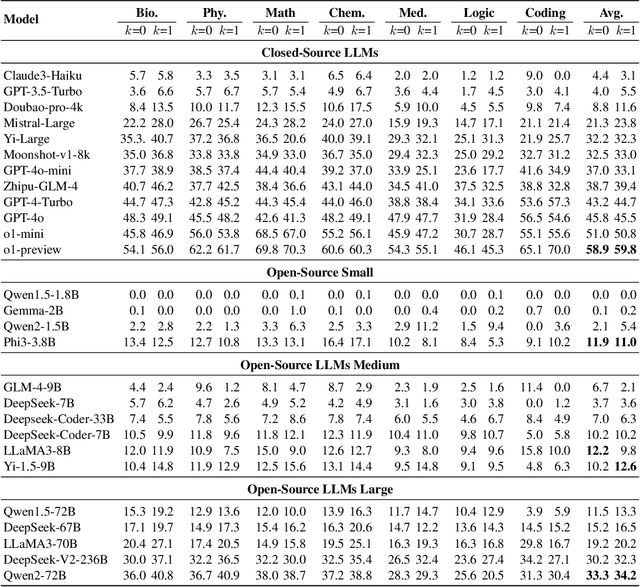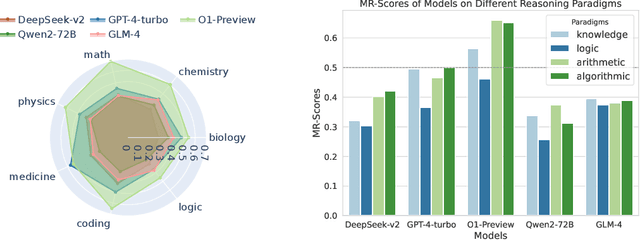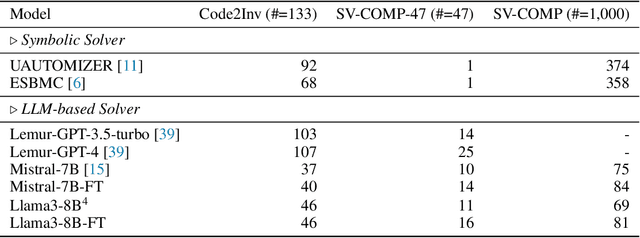Jianqiao Lu
Kimina-Prover Preview: Towards Large Formal Reasoning Models with Reinforcement Learning
Apr 15, 2025Abstract:We introduce Kimina-Prover Preview, a large language model that pioneers a novel reasoning-driven exploration paradigm for formal theorem proving, as showcased in this preview release. Trained with a large-scale reinforcement learning pipeline from Qwen2.5-72B, Kimina-Prover demonstrates strong performance in Lean 4 proof generation by employing a structured reasoning pattern we term \textit{formal reasoning pattern}. This approach allows the model to emulate human problem-solving strategies in Lean, iteratively generating and refining proof steps. Kimina-Prover sets a new state-of-the-art on the miniF2F benchmark, reaching 80.7% with pass@8192. Beyond improved benchmark performance, our work yields several key insights: (1) Kimina-Prover exhibits high sample efficiency, delivering strong results even with minimal sampling (pass@1) and scaling effectively with computational budget, stemming from its unique reasoning pattern and RL training; (2) we demonstrate clear performance scaling with model size, a trend previously unobserved for neural theorem provers in formal mathematics; (3) the learned reasoning style, distinct from traditional search algorithms, shows potential to bridge the gap between formal verification and informal mathematical intuition. We open source distilled versions with 1.5B and 7B parameters of Kimina-Prover
FlexPrefill: A Context-Aware Sparse Attention Mechanism for Efficient Long-Sequence Inference
Feb 28, 2025Abstract:Large language models (LLMs) encounter computational challenges during long-sequence inference, especially in the attention pre-filling phase, where the complexity grows quadratically with the prompt length. Previous efforts to mitigate these challenges have relied on fixed sparse attention patterns or identifying sparse attention patterns based on limited cases. However, these methods lacked the flexibility to efficiently adapt to varying input demands. In this paper, we introduce FlexPrefill, a Flexible sparse Pre-filling mechanism that dynamically adjusts sparse attention patterns and computational budget in real-time to meet the specific requirements of each input and attention head. The flexibility of our method is demonstrated through two key innovations: 1) Query-Aware Sparse Pattern Determination: By measuring Jensen-Shannon divergence, this component adaptively switches between query-specific diverse attention patterns and predefined attention patterns. 2) Cumulative-Attention Based Index Selection: This component dynamically selects query-key indexes to be computed based on different attention patterns, ensuring the sum of attention scores meets a predefined threshold. FlexPrefill adaptively optimizes the sparse pattern and sparse ratio of each attention head based on the prompt, enhancing efficiency in long-sequence inference tasks. Experimental results show significant improvements in both speed and accuracy over prior methods, providing a more flexible and efficient solution for LLM inference.
FormalAlign: Automated Alignment Evaluation for Autoformalization
Oct 14, 2024Abstract:Autoformalization aims to convert informal mathematical proofs into machine-verifiable formats, bridging the gap between natural and formal languages. However, ensuring semantic alignment between the informal and formalized statements remains challenging. Existing approaches heavily rely on manual verification, hindering scalability. To address this, we introduce \textsc{FormalAlign}, the first automated framework designed for evaluating the alignment between natural and formal languages in autoformalization. \textsc{FormalAlign} trains on both the autoformalization sequence generation task and the representational alignment between input and output, employing a dual loss that combines a pair of mutually enhancing autoformalization and alignment tasks. Evaluated across four benchmarks augmented by our proposed misalignment strategies, \textsc{FormalAlign} demonstrates superior performance. In our experiments, \textsc{FormalAlign} outperforms GPT-4, achieving an Alignment-Selection Score 11.58\% higher on \forml-Basic (99.21\% vs. 88.91\%) and 3.19\% higher on MiniF2F-Valid (66.39\% vs. 64.34\%). This effective alignment evaluation significantly reduces the need for manual verification. Both the dataset and code can be accessed via~\url{https://github.com/rookie-joe/FormalAlign}.
Scaling Laws for Mixed quantization in Large Language Models
Oct 09, 2024



Abstract:Post-training quantization of Large Language Models (LLMs) has proven effective in reducing the computational requirements for running inference on these models. In this study, we focus on a straightforward question: When aiming for a specific accuracy or perplexity target for low-precision quantization, how many high-precision numbers or calculations are required to preserve as we scale LLMs to larger sizes? We first introduce a critical metric named the quantization ratio, which compares the number of parameters quantized to low-precision arithmetic against the total parameter count. Through extensive and carefully controlled experiments across different model families, arithmetic types, and quantization granularities (e.g. layer-wise, matmul-wise), we identify two central phenomenons. 1) The larger the models, the better they can preserve performance with an increased quantization ratio, as measured by perplexity in pre-training tasks or accuracy in downstream tasks. 2) The finer the granularity of mixed-precision quantization (e.g., matmul-wise), the more the model can increase the quantization ratio. We believe these observed phenomena offer valuable insights for future AI hardware design and the development of advanced Efficient AI algorithms.
UNComp: Uncertainty-Aware Long-Context Compressor for Efficient Large Language Model Inference
Oct 04, 2024



Abstract:Deploying large language models (LLMs) is challenging due to their high memory and computational demands, especially during long-context inference. While key-value (KV) caching accelerates inference by reusing previously computed keys and values, it also introduces significant memory overhead. Existing KV cache compression methods such as eviction and merging typically compress the KV cache after it is generated and overlook the eviction of hidden states, failing to improve the speed of the prefilling stage. Additionally, applying a uniform compression rate across different attention heads can harm crucial retrieval heads in needle-in-a-haystack tasks due to excessive compression. In this paper, we propose UNComp, an uncertainty-aware compression scheme that leverages matrix entropy to estimate model uncertainty across layers and heads at the token sequence level. By grouping layers and heads based on their uncertainty, UNComp adaptively compresses both the hidden states and the KV cache. Our method achieves a 1.6x speedup in the prefilling stage and reduces the KV cache to 4.74% of its original size, resulting in a 6.4x increase in throughput and a 1.4x speedup in inference with only a 1.41% performance loss. Remarkably, in needle-in-a-haystack tasks, UNComp outperforms the full-size KV cache even when compressed to 9.38% of its original size. Our approach offers an efficient, training-free Grouped-Query Attention paradigm that can be seamlessly integrated into existing KV cache schemes.
UncertaintyRAG: Span-Level Uncertainty Enhanced Long-Context Modeling for Retrieval-Augmented Generation
Oct 03, 2024



Abstract:We present UncertaintyRAG, a novel approach for long-context Retrieval-Augmented Generation (RAG) that utilizes Signal-to-Noise Ratio (SNR)-based span uncertainty to estimate similarity between text chunks. This span uncertainty enhances model calibration, improving robustness and mitigating semantic inconsistencies introduced by random chunking. Leveraging this insight, we propose an efficient unsupervised learning technique to train the retrieval model, alongside an effective data sampling and scaling strategy. UncertaintyRAG outperforms baselines by 2.03% on LLaMA-2-7B, achieving state-of-the-art results while using only 4% of the training data compared to other advanced open-source retrieval models under distribution shift settings. Our method demonstrates strong calibration through span uncertainty, leading to improved generalization and robustness in long-context RAG tasks. Additionally, UncertaintyRAG provides a lightweight retrieval model that can be integrated into any large language model with varying context window lengths, without the need for fine-tuning, showcasing the flexibility of our approach.
MR-BEN: A Comprehensive Meta-Reasoning Benchmark for Large Language Models
Jun 20, 2024



Abstract:Large language models (LLMs) have shown increasing capability in problem-solving and decision-making, largely based on the step-by-step chain-of-thought reasoning processes. However, it has been increasingly challenging to evaluate the reasoning capability of LLMs. Concretely, existing outcome-based benchmarks begin to saturate and become less sufficient to monitor the progress. To this end, we present a process-based benchmark MR-BEN that demands a meta reasoning skill, where LMs are asked to locate and analyse potential errors in automatically generated reasoning steps. MR-BEN is a comprehensive benchmark comprising 5,975 questions collected from human experts, covering various subjects such as physics, chemistry, logic, coding, and more. Through our designed metrics for assessing meta-reasoning on this benchmark, we identify interesting limitations and weaknesses of current LLMs (open-source and closed-source models). For example, open-source models are seemingly comparable to GPT-4 on outcome-based benchmarks, but they lag far behind on our benchmark, revealing the underlying reasoning capability gap between them. Our dataset and codes are available on https://randolph-zeng.github.io/Mr-Ben.github.io/.
FVEL: Interactive Formal Verification Environment with Large Language Models via Theorem Proving
Jun 20, 2024



Abstract:Formal verification (FV) has witnessed growing significance with current emerging program synthesis by the evolving large language models (LLMs). However, current formal verification mainly resorts to symbolic verifiers or hand-craft rules, resulting in limitations for extensive and flexible verification. On the other hand, formal languages for automated theorem proving, such as Isabelle, as another line of rigorous verification, are maintained with comprehensive rules and theorems. In this paper, we propose FVEL, an interactive Formal Verification Environment with LLMs. Specifically, FVEL transforms a given code to be verified into Isabelle, and then conducts verification via neural automated theorem proving with an LLM. The joined paradigm leverages the rigorous yet abundant formulated and organized rules in Isabelle and is also convenient for introducing and adjusting cutting-edge LLMs. To achieve this goal, we extract a large-scale FVELER3. The FVELER dataset includes code dependencies and verification processes that are formulated in Isabelle, containing 758 theories, 29,125 lemmas, and 200,646 proof steps in total with in-depth dependencies. We benchmark FVELER in the FVEL environment by first fine-tuning LLMs with FVELER and then evaluating them on Code2Inv and SV-COMP. The results show that FVEL with FVELER fine-tuned Llama3- 8B solves 17.39% (69 -> 81) more problems, and Mistral-7B 12% (75 -> 84) more problems in SV-COMP. And the proportion of proof errors is reduced. Project page: https://fveler.github.io/.
Process-Driven Autoformalization in Lean 4
Jun 04, 2024



Abstract:Autoformalization, the conversion of natural language mathematics into formal languages, offers significant potential for advancing mathematical reasoning. However, existing efforts are limited to formal languages with substantial online corpora and struggle to keep pace with rapidly evolving languages like Lean 4. To bridge this gap, we propose a new benchmark \textbf{Form}alization for \textbf{L}ean~\textbf{4} (\textbf{\name}) designed to evaluate the autoformalization capabilities of large language models (LLMs). This benchmark encompasses a comprehensive assessment of questions, answers, formal statements, and proofs. Additionally, we introduce a \textbf{P}rocess-\textbf{S}upervised \textbf{V}erifier (\textbf{PSV}) model that leverages the precise feedback from Lean 4 compilers to enhance autoformalization. Our experiments demonstrate that the PSV method improves autoformalization, enabling higher accuracy using less filtered training data. Furthermore, when fine-tuned with data containing detailed process information, PSV can leverage the data more effectively, leading to more significant improvements in autoformalization for Lean 4. Our dataset and code are available at \url{https://github.com/rookie-joe/PDA}.
AutoCV: Empowering Reasoning with Automated Process Labeling via Confidence Variation
May 29, 2024Abstract:In this work, we propose a novel method named \textbf{Auto}mated Process Labeling via \textbf{C}onfidence \textbf{V}ariation (\textbf{\textsc{AutoCV}}) to enhance the reasoning capabilities of large language models (LLMs) by automatically annotating the reasoning steps. Our approach begins by training a verification model on the correctness of final answers, enabling it to generate automatic process annotations. This verification model assigns a confidence score to each reasoning step, indicating the probability of arriving at the correct final answer from that point onward. We detect relative changes in the verification's confidence scores across reasoning steps to automatically annotate the reasoning process. This alleviates the need for numerous manual annotations or the high computational costs associated with model-induced annotation approaches. We experimentally validate that the confidence variations learned by the verification model trained on the final answer correctness can effectively identify errors in the reasoning steps. Subsequently, we demonstrate that the process annotations generated by \textsc{AutoCV} can improve the accuracy of the verification model in selecting the correct answer from multiple outputs generated by LLMs. Notably, we achieve substantial improvements across five datasets in mathematics and commonsense reasoning. The source code of \textsc{AutoCV} is available at \url{https://github.com/rookie-joe/AUTOCV}.
 Add to Chrome
Add to Chrome Add to Firefox
Add to Firefox Add to Edge
Add to Edge